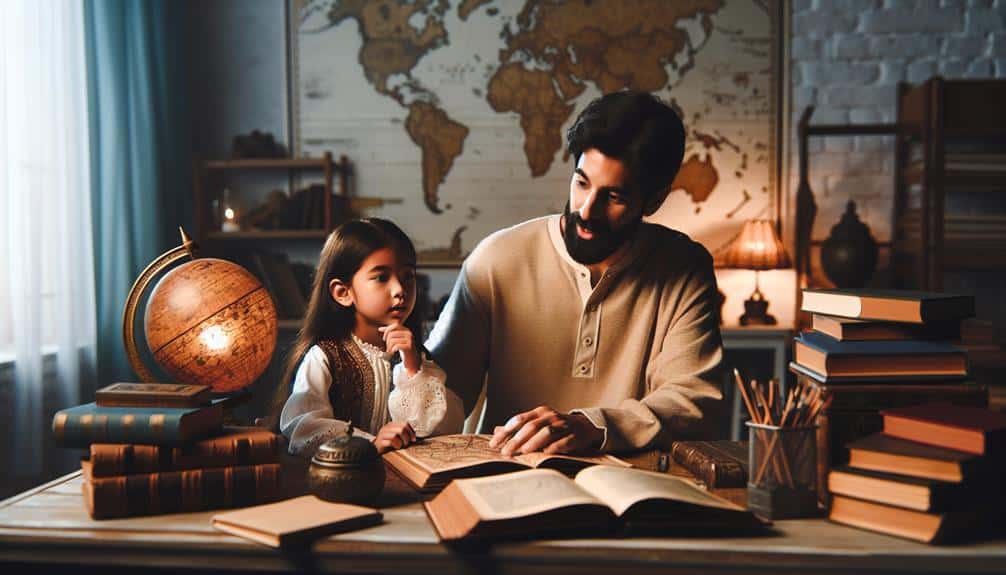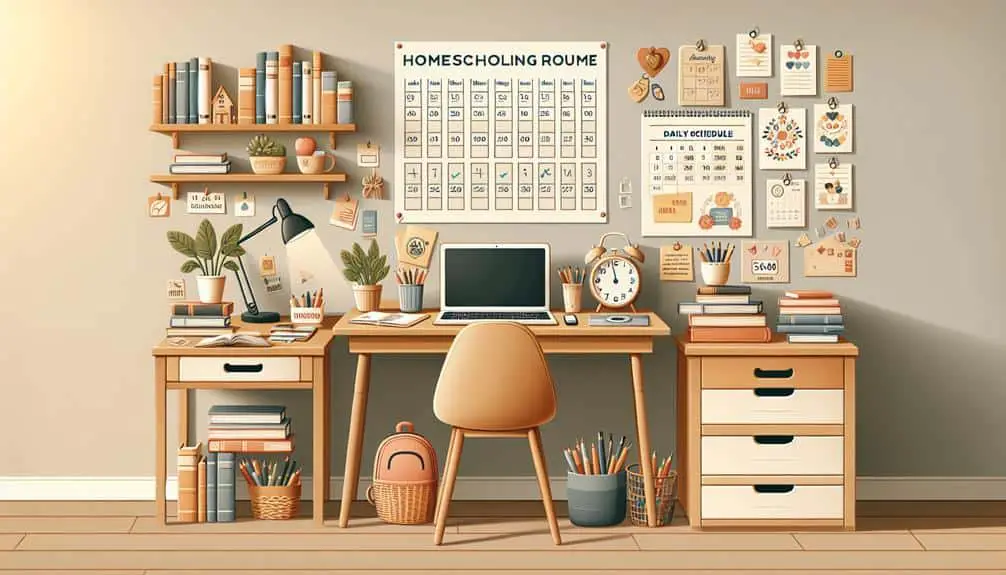Immerse yourself in history at home! Start by organizing field trips to museums and living history events for hands-on learning. Engage with interactive timeline tools for a visual journey through the past. Encourage role-playing historical events for a compelling connection to history. Engage with multimedia like documentaries and podcasts to spark lively discussions. Help your children with independent research projects using primary sources. Don historical attire and create immersive living history days. Develop educational games and scavenger hunts for an enjoyable way to learn. Ready to bring history alive? Explore these seven engaging techniques for an enriching historical journey!
Key Points
- Incorporate field trips, virtual tours, and living history events for immersive learning.
- Utilize interactive timeline tools for hands-on exploration of different time periods.
- Engage children in role-playing historical events and fashion for interactive experiences.
- Use multimedia resources like virtual tours, documentaries, and podcasts to spark discussions.
- Encourage independent research projects with interactive timelines and creative presentations.
Incorporating Field Trips
Enhance your history lessons by incorporating engaging field trips to bring the past to life for your children.
Take advantage of virtual tours to explore historical sites from the comfort of your home. Many museums and historical sites now offer interactive online experiences that can transport you and your children back in time. These virtual tours provide a unique opportunity to see historical artifacts up close and learn about significant events in an immersive way.
When possible, consider visiting local museums to give your children a hands-on experience with history. Many museums offer interactive exhibits and educational programs that can make learning about the past exciting and memorable.
Additionally, attending living history events where actors reenact historical scenes can provide a vivid and engaging way for your children to connect with the past.
Utilizing Interactive Timeline Tools
Discover the power of interactive timeline tools to make history come alive for your children in a dynamic and engaging way. Interactive timeline apps can provide a hands-on approach to learning about historical events. These tools allow your children to explore different time periods, important dates, and significant figures in a visually appealing manner. By utilizing timeline visualization, your children can develop a better understanding of how events are interconnected throughout history.
Virtual field trips through interactive timeline apps can transport your children to different eras and locations, immersing them in the historical context. They can virtually visit ancient civilizations, revolutionary battles, or significant cultural movements, enhancing their learning experience.
Incorporating historical games into interactive timelines can also make learning fun and interactive. By engaging in activities that require them to make decisions based on historical information, your children can develop critical thinking skills while enjoying the learning process.
Take advantage of these interactive tools to create an enriching history curriculum for your children at home.
Role-Playing Historical Events
Immerse your children in history by engaging in role-playing historical events, allowing them to experience the past firsthand through interactive and engaging activities.
Delve into different time periods by incorporating historical fashion into your role-playing games. Encourage your kids to dress up in attire from specific eras, whether it's togas for ancient Rome or flapper dresses for the Roaring Twenties. This hands-on approach not only makes history come alive but also helps in understanding the customs and traditions of the time.
To enhance the experience further, consider incorporating improvisational theatre techniques. Encourage your children to act out scenarios based on historical events, putting themselves in the shoes of significant figures or ordinary people from the past. This not only fosters creativity but also deepens their connection to the subject matter.
Engaging Multimedia Resources
Explore a variety of engaging multimedia resources to make history come alive for your children during homeschooling sessions. Enhance their learning experience by incorporating virtual tours, documentaries, podcasts, and animations into your history curriculum.
- Virtual Tours:
Take your children on virtual tours of historical sites and museums around the world. This interactive experience allows them to explore different time periods and cultures from the comfort of your home.
- Documentaries:
Watch historical documentaries together to provide a visual and informative perspective on significant events and figures. Documentaries can spark discussions and deepen your children's understanding of historical context.
- Podcasts and Animations:
Introduce your children to history through engaging podcasts and animations that present information in a dynamic and entertaining way. These resources can help bring historical stories to life and capture your children's attention.
Encouraging Independent Research Projects
Ready to take your history lessons to the next level? Get ready to explore exciting project ideas, discover valuable research resources, and choose from a variety of presentation options.
Let's immerse ourselves in the world of independent research projects and ignite your creativity in learning history at home!
Project Ideas
Encourage your child's curiosity and critical thinking skills by guiding them in selecting and developing independent research projects related to historical topics. Engaging in hands-on projects and creating creative presentations can make history come alive for your child.
Here are some project ideas to spark their interest:
- Hands-On Projects: Encourage your child to explore historical artifacts or documents using craft materials. This hands-on approach can help them understand the context and significance of these items better.
- Creative Presentations: Have your child prepare a dramatic monologue or a visual presentation about a historical figure or event. This allows them to investigate deeply into the subject and present it in a unique and engaging way.
- Interactive Timelines and Virtual Tours: Help your child create interactive timelines showcasing key events or take virtual tours of historical sites online. This interactive approach can enhance their understanding of the chronological order of events and provide a visual connection to historical locations.
Research Resources
Utilize a variety of research resources to empower your child in undertaking independent historical projects, fostering a deeper understanding and appreciation of the past. Encouraging the use of primary sources is key to developing critical thinking skills and gaining authentic insights into historical events. Primary sources are firsthand accounts or artifacts from the time period being studied, providing a direct connection to the past.
Online databases offer a treasure trove of historical information at your fingertips. Websites like the Library of Congress, National Archives, or specific historical society databases can be invaluable tools for conducting in-depth research. These platforms host digitized primary sources such as letters, photographs, newspapers, and government documents, allowing your child to engage directly with history.
Presentation Options
To enhance your child's understanding of history further, explore various presentation options that can inspire and showcase their independent research projects effectively. When it comes to encouraging independent research projects in history, the presentation plays an important role in engaging your child and helping them develop a deeper connection to the subject matter.
Here are some creative ways to present their findings:
- Virtual Presentations: Encourage your child to create engaging slideshows or videos to present their research virtually. This can help them practice their digital skills while sharing their knowledge with others.
- Hands-on Projects: Building dioramas, creating timelines, or crafting historical artifacts can provide a hands-on approach to presenting research. These projects can make history come alive for your child.
- Storytelling and Creative Displays: Encourage your child to narrate historical events creatively through storytelling or showcase their findings using visually appealing displays. This can enhance their communication skills and creativity while presenting their research.
Organizing Living History Days
Ready to transport your family back in time with Living History Days?
Engage in historical reenactments, hands-on learning activities, and intriguing costuming and props to bring the past to life right in your home.
Get ready for an immersive and interactive history lesson like never before!
Engaging Historical Reenactments
Consider incorporating engaging historical reenactments through the organization of Living History Days to bring the past to life for your homeschool history lessons. Historical reenactments can provide immersive experiences that make learning history exciting and memorable.
Historical Costumes:
Encourage your children to dress up in period-appropriate clothing to fully immerse themselves in the time period being studied. This hands-on approach helps them connect with historical figures and events on a deeper level.
Role Playing:
Engage in role-playing activities where each family member takes on a different historical persona. This interactive learning opportunity allows everyone to experience history from multiple perspectives and understand the complexities of different eras.
Interactive Learning Opportunities:
Set up stations with activities that reflect aspects of the historical period, such as crafts, games, or cooking traditional recipes. This hands-on approach fosters a deeper understanding of history through active participation.
Hands-On Learning Activities
Explore the world of hands-on learning activities by immersing your family in the past with the organization of Living History Days in your homeschool history curriculum. Museum visits can be transformed into exciting adventures by actively participating in historical crafts and educational games. These experiences bring history to life in a tangible and memorable way.
Engaging in hands-on projects allows your family to investigate further into the historical context of different time periods. From creating artifacts to reenacting historical events, these activities provide a unique perspective that goes beyond traditional textbook learning. By stepping into the shoes of people from the past, you can gain a better understanding of their lives and the challenges they faced.
Educational games add an element of fun to your history lessons while reinforcing key concepts. Whether it's solving historical puzzles or participating in simulated historical scenarios, these games make learning interactive and enjoyable.
Costuming and Props
Immerse your family in the past by organizing Living History Days with a focus on costuming and props to enhance the historical experience. Historical fashion and theatrical accessories can transport you to different eras, making history come alive in your own home.
Here are some tips to create an engaging and educational experience:
- Research Historical Fashion: Explore different time periods and their fashion trends. Encourage your family to dress up in clothing that represents a specific era, whether it's the roaring twenties or the medieval period.
- Get Creative with Costume Design: Use everyday items to craft costumes that reflect the style of the past. This hands-on approach allows for a deeper understanding of historical clothing construction.
- Engage in Prop Making: Props can add authenticity to your living history day. Create simple props like scrolls, quills, or even makeshift weaponry to further immerse yourselves in the time period you're exploring.
Creating Educational History Games
Enhance your history lessons at home by incorporating engaging educational games that make learning memorable and fun.
Historical scavenger hunts and trivia games are fantastic ways to spark interest and reinforce historical facts. You can create scavenger hunts where kids search for clues related to different historical events or figures around the house.
Trivia games can cover various historical topics and encourage friendly competition among family members.
Interactive storytelling is another effective method to dive deep into historical events. You can narrate stories from different time periods, involving children in the narrative by assigning them roles or letting them make decisions that impact the story's outcome. This approach makes history come alive and helps kids connect emotionally with the past.
Timeline challenges are excellent for teaching the chronological order of historical events. Create a visual timeline and ask children to place key events in the correct sequence. This hands-on activity enhances their understanding of how different events are interconnected throughout history.
Incorporating these educational games into your history lessons won't only make learning enjoyable but also leave a lasting impact on your child's knowledge retention.
Frequently Asked Questions
How Can I Assess My Child's Progress in History at Home?
To assess your child's progress in history at home, try using timeline assessments and oral quizzes. Encourage project presentations and written reflections to gauge understanding. These methods help track learning and spark insightful discussions.
What Are Some Strategies to Make History Lessons More Interactive?
Want to immerse yourself in history lessons? Engage in role playing to bring historical events to life. Interactive games like trivia or scavenger hunts make learning fun. Get creative and watch history come alive!
Are There Any Online Resources for Virtual History Field Trips?
Looking to explore the past from home? Immerse yourself in virtual museum tours for immersive experiences. Engage with online historical reenactments and educational documentaries to make history come alive. Expand your knowledge with interactive history lessons.
How Can I Incorporate Historical Artifacts Into Our Lessons?
To incorporate historical artifacts into your lessons, try artifact exploration for hands-on learning. Visit museums for real-world connections. Encourage curiosity by touching, examining, and discussing artifacts to bring history to life in your home classroom.
What Are Some Creative Ways to Make History Relevant to My Child's Life?
To make history relevant, immerse your child in role-playing activities like pretending to be historical figures. Explore family history together and read historical fiction. Learning through games can also make the past come alive!



